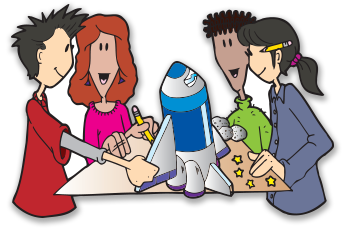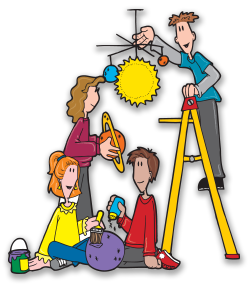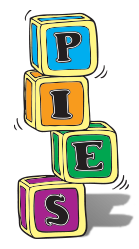Kagan's Articles - FREE Kagan Articles
Articles by Dr. Vern Minor
Kagan Connections–Project Based Learning
Special Article
Kagan Connections—Project Based Learning
Dr. Jackie Minor and Dr. Vern Minor
To cite this article: Minor, V., Minor, J. Project Based Learning. Kagan Online Magazine, Issue #58. San Clemente, CA: Kagan Publishing. www.KaganOnline.com

Background
Learning by doing. Advocates of this philosophy of education have voiced their support for this pedagogical approach for decades. No one knows for certain the origins of this concept. In reality, man has been “learning by doing” since he set foot on this earth. Discovery by trial and error can certainly be categorized as a form of learning by doing. However, in terms of the impact this idea has had on education, most historians attribute this theory to John Dewey.
Dewey, an American philosopher and pioneer of progressive education, outlined the concept of “learning by doing” in his 1897 book entitled, My Pedagogic Creed. Dewey advocated that learning should not be passive and theoretical, a method of teaching we sometimes refer to in layman’s terminology as “sit and get.” On the contrary, he promoted a learning experience that was relevant, practical, and hands-on. Dewey claimed, “I believe that the school must represent present life—life as real and vital to the child as that which he carries on in the home, in the neighborhood, or on the playground” (Dewey, p. 77).
This notion—learning by doing—is foundational to an educational approach known as Project Based Learning (PBL). PBL initially was an educational approach that was first introduced in vocational training. Michael Knoll, in his study The Project Method: Its Vocational Education Origin and International Development, describes how project work had its beginnings at architectural schools in Europe from 1590–1765. Later, project work was incorporated into engineering schools in the United States in the latter part of the 16th century (Pannabecker). The use of projects for learning has long been a vital component of vocational training and higher education.
Recently, a growing number of educators have begun introducing PBL into K–12 classrooms. Like many new initiatives, however, there are difficulties that must be overcome. The purpose of this article is not to address every challenge or every component of PBL. Rather, the intent of this article is to illustrate how two concepts—PBL and Kagan Cooperative Learning—can and should be integrated. By combining these two teaching methods, many of the hurdles facing PBL can be overcome.
What Is Project Based Learning?
There is no single accepted definition of PBL. However, what is clear is that PBL is not simply doing projects with students. Teachers have been assigning projects to students for eons. Such projects—reports, posters, research—are typically assigned after students have learned new content as a way of providing students with an opportunity to demonstrate their new learning. In PBL, projects are produced; however, projects do not serve as a culminating event to learning. Rather, PBL places more emphasis on the process of learning and collaboration than on the actual end product itself (TeachThought Staff).
In PBL the creation of the project becomes the means by which students learn new material. The Buck Institute for Education (BIE) is a leader in the field of PBL. According to BIE, PBL is far more than simply assigning “…fun or change-of-pace events completed after students have pushed through homework assignments, lectures, and tests” (BIE, Introduction to PBL). PBL is “a systematic teaching method that engages students in learning knowledge and skills through an extended inquiry process structured around complex, authentic questions and carefully designed products and tasks" (BIE, Introduction to PBL). BIE has identified the components listed below as essential project design elements (BIE, What is PBL?).
- Key Knowledge, Understanding, and Success Skills
- Challenging Problem or Question
- Sustained Inquiry
- Authenticity
- Student Voice and Choice
- Reflection
- Critique and Revision
- Public Product
Why are so many schools exploring the concept of PBL? There are many potential merits to this strategy. Edutopia, a website published by the George Lucas Educational Foundation, has identified PBL as one of its six core learning strategies. They cite a number of possible virtues of PBL (Edutopia, Why Is PBL Important?).
- PBL helps students develop skills for living in a knowledge-based, highly technological society.
- PBL and technology use bring a new relevance to the learning at hand.
- PBL lends itself to authentic assessment.
- PBL promotes lifelong learning.
- PBL accommodates students with varying learning styles and differences.
Similarly, BIE offers a list of reasons for why PBL’s time has come (BIE, Why PBL?).
- PBL makes school more engaging for students.
- PBL improves learning.
- PBL builds success skills for college, career, and life.
- PBL helps address standards.
- PBL provides opportunities for students to use technology.
- PBL makes teaching more enjoyable and rewarding.
- PBL connects students and schools with communities and the real world.
No one can argue that the world of work has radically changed. The employability skills of the 21st century are far different than in eras past. Communications, collaboration, critical thinking, shared decision making, social responsibility—the list of skill sets students need to master all point to the importance of students being able to function effectively with others. PBL is an attempt to accomplish exactly that—prepare students for the interdependent world in which they will live. However, while PBL holds promise, there are challenges associated with this pedagogical methodology.
Challenges of Project Based Learning

Removing students from “sit and get” mode and, instead, placing them in team settings where they are confronted with real world issues makes sense in this day and age. However, while the potential benefits to PBL are many, they are exactly that—potential. BIE recognizes this reality. “As a field, PBL is still in the developmental stage… there is not sufficient research or empirical data to state that PBL is a proven alternative to other forms of instruction” (BIE, Introduction to PBL, page 5). The advantages espoused by PBL advocates will only be accrued when and if the obstacles facing PBL are addressed.
These challenges are rooted in a foundational issue—being able to craft carefully designed tasks. As PBL has been introduced to the K–12 realm, most of the focus has been concentrated in two domains: (1) creating links to curricular standards; and (2) building effective assessments. This should not surprise educators since these two areas—curriculum standards and assessments—have been focal points for much of the work that has transpired in educational reform over the past four decades. However, what has been lacking in school improvement efforts and what is a root cause for many of the challenges associated with PBL is the attention given to instruction. According to BIE, “… results vary with the quality of the project and the level of student engagement” (BIE, Introduction to PBL, page 6).
If projects are not structured tightly enough to ensure all students are fully engaged with the content and activities, the benefits associated with PBL will only be realized by a few students. Students cannot simply be encouraged to participate in interdependent tasks. The reality is this—when students are invited to be engaged, many decline the invitation. This issue—making certain all students are fully engaged—lies at the heart of why achievement gaps continue to exist after decades of educational reform. When pedagogy is loosely structured, a significant number of students will choose to disengage.
PBL is not exempt from this potential problem. In fact, in many ways a PBL classroom is more susceptible to two concerns which haunt interdependent activities in classrooms: (1) some students hide; and (2) some students do the work for others. Any PBL activity that allows these two problems to persist will result in many students being disengaged; this, in turn, will contribute to achievement gap growth. Experts in the field who support PBL acknowledge that this is an inherent challenge. Consider the testimonials below that have been voiced by PBL advocates.
“Sometimes group dynamics issues compromise PBL effectiveness. Group dynamics issues may require faculty intervention.”
—Weimer“If one is not careful, it is very easy to allow some pupils to get away with doing very little.”
—Freedman“A student-centered pedagogy is only as effective as the students are engaged psychologically (e.g., motivation and interest) and are provided meaningful and relevant real-world challenges.”
—Thomas“Designing meaningful, engaging, challenging projects is not easy.”
—Rogers“Studies show that teachers have problems with… creating a culture of collaboration and interdependence in the school environment.”
—Sithenjwa
Other difficulties certainly face PBL (e.g., aligning projects to standards, identifying a rich problem to solve, assessing individual contributions accurately, finding resources to support the work of facilitation). However, all of these pale in comparison to the most critical element to ensuring success—engaging all students equally in the project. If equal participation and individual accountability are compromised, PBL will not be successful, and learning gaps will increase.
Enhancing Project Based Learning
So what can be done to strengthen PBL? Thanks to the work of groups like BIE and Edutopia, many of the issues related to curriculum and assessment are being addressed. While there is still work to be done in these areas, considerable progress has been made in recent years. The biggest obstacle facing advocates of PBL lies in the realm of instruction. Vega (2105) noted that one of the critical keys to PBL success is structured group work. How can engagement of all be ensured? Structure—that is the answer! This is where Kagan and PBL connect.

By definition, “a Cooperative Learning Structure: (1) organizes classroom instruction; (2) is contentfree and repeatable; and (3) implements the basic principles of cooperative learning (PIES)” (Kagan, page 6.2). In other words, a Kagan Structure “structures” interaction so that all students are fully engaged with the content and with each other. When all students are engaged with the content, achievement gaps narrow; when all students are engaged with each other, skills sets that are important in life and the world of work are developed.
Embedding Kagan Structures in PBL activities strengthens projects. Cooperative structures contain four basic principles which can be remembered with the acronym PIES—Positive Interdependence, Individual Accountability, Equal Participation, and Simultaneous Interaction. When PIES is embedded in a project, all students become contributing members of the team. By marrying PBL and Kagan Structures together, students cannot choose to disengage.
So what would that look like? How can Kagan Structures and PBL coexist? There is no formula for how to integrate these two strategies; how this occurs will vary from project to project. However, for purposes of illustration, let’s examine one PBL activity to see how integrating Kagan Structures bolsters the exercise.
Sample Project
Highlighted below are components of a grade 7 social studies project. We have refrained from citing the source of this document because in no way do we want to slight the work that has been done. Quite the contrary—we applaud the efforts of all who were involved in the creation of this project. However, there are a number of places where Kagan Structures can be added to strengthen the project. Five examples of this integration are outlined. For each example, the current directions of the project as designed are noted. Following this is one way Kagan could be inserted to enhance the degree to which students are active in the project.
Example 1
Current Directions
Students will use the Frayer Model to record major examples of geographic terminology and other key vocabulary terms.
Revised Directions—Integration of Kagan
The Frayer Model is a graphic organizer used for word analysis and vocabulary building. By integrating RoundTable Consensus, all students would be involved in completing the graphic organizer.
- Each student shares an idea and checks for agreement.
- If all teammates agree, the idea is recorded.
- If there is disagreement, the idea is discussed until agreement is reached.
- The next student shares.
Example 2
Current Directions
Students will know and use correct geographic terminology.
Revised Directions—Integration of Kagan
Learning proper terminology is critical to the success of any project. Quiz-Quiz-Trade is an exceptional way for students to learn facts and information.
- Students stand, carry their question card, and find a partner.
- Partner A quizzes Partner B, coaching if necessary.
- Partners switch roles.
- Partners trade cards, find a new partner, and repeat.
Example 3
Current Directions
Students will explain how physical features impact people positively and negatively in relation to one’s standard of living and cultural experiences.

Revised Directions—Integration of Kagan
Seeing both sides of an issue is crucial for students. A powerful Kagan Structure that ensures students learn how to shift perspectives is Pros-N-Cons.
- Students sit facing a partner.
- Using Timed Pair Share…
• A’s present the Pros for a given position.
• B’s present the Cons for a given position. - Participants switch partners and positions and repeat.
Example 4
Current Directions
Students will conduct Internet research to learn more details about the area.
Revised Directions—Integration of Kagan
No direction is provided regarding how the research is going to be conducted. If this is the only direction given to students, some will clearly not pull their weight. A way to equalize the research workload would be to utilize Within Team Jigsaw.
- Students independently become an expert in one area.
- Using Timed RoundRobin, students take turns sharing their expertise.
Example 5
Current Directions
Students will produce a vlog.
Revised Directions—Integration of Kagan
Integration of technology is common in PBL. However, as is the case with Example 4, if no directions are provided other than encouraging students to work together, some will contribute far less than others. Cooperative Projects integrate the PIES principles, thereby ensuring all are equally participating and individually accountable. By manipulating roles and resources, it is possible to make PIES come alive in any project. Students can still have some degree of autonomy to make team decisions; however, directions for the project need to ensure that PIES is embedded throughout.
This is certainly not an all-inclusive list regarding how this project could be enriched. There are a number of other ways that all children could become more active in this project. For example, Kagan Structures could be integrated to enable students to…
- build a culture of trust, cohesiveness, and interdependence.
- brainstorm questions they want to address in the project.
- work together collaboratively to narrow the scope of their work.
- reach true consensus on team decisions that must be made.
- provide constructive feedback to peers.
- present a public project to individuals, teams, or large groups.
- reflect on what they have learned in the experience.
When students must determine the process by which the tasks in the project are completed, the two problems mentioned earlier surface—some choose to disengage while others take over the project. Instruction (i.e., how students are to complete the project) cannot be left to children to decide. It is possible to provide structure to a project and still provide opportunities for students to make choices. It does not have to be an either/or proposition; it can be a both/and. Failing to structure interaction, however, will create problems. Without structure, students will disengage, off-task behavior will escalate, classroom management issues will surface, and academic achievement will be compromised.
Final Thoughts
PBL is a promising strategy that should continue to be explored in our nation’s schools. It is difficult to argue with the potential benefits this approach offers to children. However, learning by doing—if not structured tightly—fails to deliver these advantages. Kagan Structures—when married to PBL—will enable educators to create effective projects that engage all students.
If we hope to create a profession of highly qualified educators, we must embrace changes in instructional practices. Kagan has a long and proud history of helping schools across the country boost academic gains and narrow the achievement gap. It is our hope that we can establish a long-term relationship with your organization as you strive to improve the achievement of all children. If you would like to learn more about the information in this article, please feel free to contact either of the educators listed below.
Contacts
 Jackie Minor, Ed.D.
Jackie Minor, Ed.D.
Director of District Implementation
jackie@kaganonline.com
949.545.6382
 Vern Minor, Ed.D.
Vern Minor, Ed.D.
Director of Educational Leadership
vern@kaganonline.com
949.545.6381
